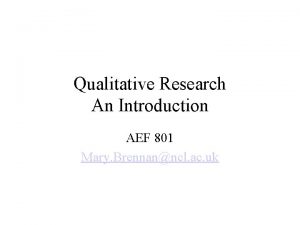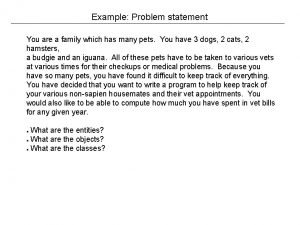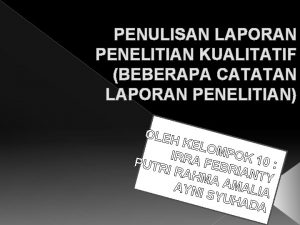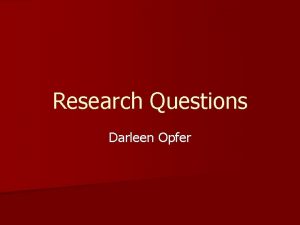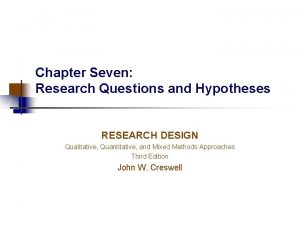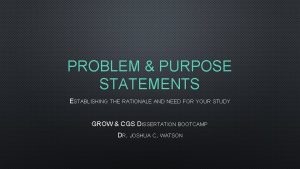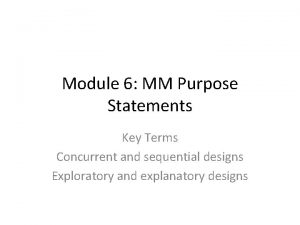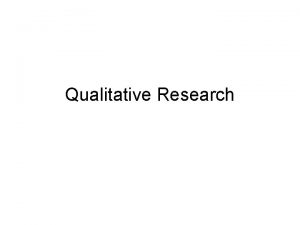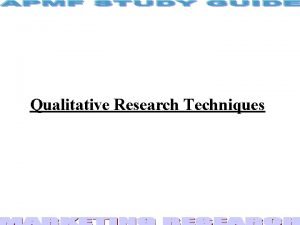WRITING QUALITATIVE PURPOSE STATEMENTS RESEARCH QUESTIONS Purpose Statement














- Slides: 14

WRITING QUALITATIVE PURPOSE STATEMENTS / RESEARCH QUESTIONS

Purpose Statement ■ A purpose statement shows the intent to explore or understand the central phenomenon. ■ In a purpose statement – Use key identifier words (e. g. The purpose of this study is…) – Consider mentioning that the study is qualitative – Indicate the type of research design – State the central phenomenon you want to explore – Use words such as explore, discover, understand, and describe – Mention the participants – Refer to the research site

A sample purpose statement ■ The purpose of this qualitative study is to (explore/discover…) (the central phenomenon) for (participants) at (research site) ■ E. g. ■ The purpose of this qualitative study is to describe classroom learning using the internet for five high school students participating in a sign language class

Research Questions ■ Research questions force you to consider the issue more precisely and rigorously. ■ It provides an explicit statement of what it is the researcher wants to know about. ■ It must have a question mark at the end of it or else it is not a question.

Importance of Research Question(s) ■ Research questions are crucial because they will – guide your literature search; – guide your decisions about the kind of research design to employ; – help you decide what data to collect and from whom; – guide your analysis of your data; – guide your writing-up of your data; – stop you from going off in unnecessary directions; and – provide your readers with a clearer sense of what your research is about.

DEVELOPING QUALITATIVE RESEARCH QUESTIONS

General Info ■ Qualitative research questions are open-ended and general ■ They can change and/or emerge during the study ■ Most of the time a few general questions are enough ■ Neutral and exploratory language is used – E. g. Generate, discover, understand, describe, explore – INSTEAD OF – Affect, relate, compare, determine, cause, influence ■ Two types of questions can be used: central question and subquestions

Central Questions ■ It is the overaching question we want to explore. ■ We consider the most general question we can ask ■ There are some strategies to be used while designing this quesiton: – A) Begin with How or What (not Why) so you suggest exploration – B) Specify the central phenomenon – C) Identify the participants – D) Mention the resarch site

Some Poor Examples Problems Poor Better Too General What is going on here? What is the process being used by the general education committee at the liberal arts school? Too Focused How did the committee make a curriculum decision about a course on the environment? What is the process of the curriculum committee in making decisions about courses? Too laden with assumptions How did the curriculum committee address its alienation from the college administration? What was the role of the college administration in the curriculum committee’s deliberations?

Sample qualitative research questions in published articles ■ https: //bop. unibe. ch/linguistik-online/article/view/1278/2132 ■ http: //www. wjeis. org/File. Upload/ds 217232/File/01. watcharaph ong_soongpankhao. pdf ■ https: //files. eric. ed. gov/fulltext/EJ 1066020. pdf ■ https: //www. jstor. org/stable/pdf/24156232. pdf? refreqid=excelsi or%3 A 001 b 9137 e 353 bee 690 a 136 df 43 ccbfed

Subquestions ■ Subquestions refine the central question into subquestiones to be addressed ■ Like the central question, they are open-ended, emerging, neutral, and few in number ■ They provide greater specificity to the questions

Sample Subquestions ■ Central Question: What is self-esteem for high school students? ■ Subquestions: – 1. What is self-esteem as seen through friends? – 2. What is self-esteem for the participant’s family? – 3. What is self-esteem as experienced in extracurricular activities in school?

An in-class activity ■ Step 1: – – – Take out a piece of paper Think for a few minutes about some topics that interest you and jot down these topics in a corner of your paper Select one of the topics and write it in the middle of your paper For 5 minutes, write down the topics and ideas that relate to the main topic; connect and cluster similar ideas When you have finished, see if you have any patterns (e. g. age group, gender, type of person, etc. )

■ Step 2. ■ Now write your purpose statement ■ Step 3. ■ Now write your research question(s) ■ Go through other qualitative articles and find out the research questions. ■ Compare those research questions in the article with those of yours
 Qualitative purpose statement
Qualitative purpose statement Nature of qualitative research
Nature of qualitative research Similarities of qualitative and quantitative research
Similarities of qualitative and quantitative research Sample of appendices in research paper
Sample of appendices in research paper Parts chapter 3 research
Parts chapter 3 research Quantitative vs qualitative experiment
Quantitative vs qualitative experiment Statement of the problem examples
Statement of the problem examples Notes on report writing
Notes on report writing Types of quantitative research questions
Types of quantitative research questions How to pose a research question
How to pose a research question Purpose statement in research example
Purpose statement in research example Examples of rationale statements
Examples of rationale statements Purpose statement in research example
Purpose statement in research example Example of problem statement in research proposal pdf
Example of problem statement in research proposal pdf Thesis statement example
Thesis statement example


